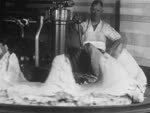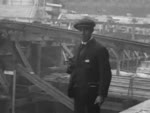MAKING SOAP: SCWS Soap Manufacture
Full length video
Please read Understanding catalogue records for help interpreting this information and Using footage for more information about accessing this film.
Title: MAKING SOAP: SCWS Soap Manufacture
Reference number: 0877
Date: 1928
Sponsor: [ SCWS]
Sound: silent
Original format: 35mm
Colour: bw
Fiction: non-fiction
Running time: 24 mins
Description:
The manufacturing of soap at the Co-op's Grangemouth factory.
The Grangemouth soap works of the SCWS were opened in 1897 for the supply of retail societies in Scotland.
For further information see "The British Co-operative Movement Film Catalogue" compiled and edited by Alan Burton 1997.
Preservation of this film supported by the National Heritage Memorial Fund.
Credits: "The making of high-class soaps, soap powders, etc as carried on by the Scottish Co-operative Wholesale Society Limited, in the largest factory of this kind in Scotland. The manufacture of candles has been added recently and met with instant success."
Shotlist:
Reel I
Credits (.24) Exterior factory complex (.35) If "cleanliness is next to Godliness" the activities of the SCWS Ltd at Grangemouth must be of paramount importance to co-operators. Tallow, palm oil, cotton oil and many other vegetable oils are the raw materials used in the manufacture of soap. Practically every country in the world supplies some ingredient for its manufacture (.56) Shot of railway siding with barrels stored on either side (1.02) the solid fats are stored in the open whilst liquid oils and fats are kept in tanks. Barrels are unloaded from LMS railway wagon by crane (1.40) Soap is made by boiling oils and fats with caustic soda in large boiling pans, the pans hold 50 tons of soap. Liquid is poured from valve into open tank (1.54) To separate the soap from the glycerine which is made at the same time common salt is thrown in and boiled through. Salt is shovelled into the tanks (2.33) Boiling is done by blowing steam into the pan and the process of boiling is called saponification. Steam rises through the boiling liquid in the pan (3.18) The contents in the pan setlte out soap on the top and a brown liquid containing salt, glycerine and water is at the bottom. This lye is run off to the glycerine department for treatment, no soap is allowed to run off with the lye. The lye is run off via a valve in the bottom of the pan (4.02) After the soap is washed free of glycerine and properly "fitted" it is allowed to settle for a few days. Then it is run off into mixing pots and the necessary colours and perfumes are mixed into the soap. Shots as additives are combined with liquid soap (5.03) The soap is then run into portable frames, or boxes, each holding 12 cwts. The sides and ends are detachable, very necessary to effect quick cooling (5.17) Liquid soap is run into a large box which is then stored beside a great many others (6.11) Yes madam, all soap, tons of it, to wash clothes and little black boys and girls in Bonnie Scotland. Shots of solid blocks of soap each about 1.5m in length (6.46) The blocks of soap are lifted to the cutting machines, are cut first vertically and then horizontally, notice the wires which are the cutters, the bars are carefully examined. Large block of soap is hoisted into the air. Wire cutters first descend down through the soap then pass through horizontally. Man checks some of the cut bars (7.59) The bars are piled and after drying are stamped and wrapped (8.06) Shots in busy packing department (9.01) Observe how the filled boxes are conveyed to the warehouse on the gravity runway. Gently sloping runway with roller bars causes the boxes to slide down to the warehouse (9.54)
Reel II
No credits. Sit up ladies and take notice, your beautiful complexions demand it. The process of toilet soap making briefly described is the thorough incorporation of choice perfumes to specially prepared soap. Bars of special soap are chipped, dryed and then conveyed to storage bins. Bars of soap are fed into the "chipping machine" (.40) chips are dried on a conveyor (.59) The process of mixing perfumes with soap is called "French milling" - notice the ribbons of soap after milling. The ribbons of soap are placed in a plodder like a big sausage machine. Ribbons of soap emerge from milling machine (1.30) two girls operate the machine which reconstitutes the soap ribbons into solid bars (1.50) Observe how the tablets are cut off automatically. The tablets are carefully stamped by hand to give the perfect outline and finish. The camera follows the progress of cut tablets from plodder to hand-operated stamping machines (3.05) tablet of soap is stamped with the words "palm and olive oil soap" (3.09) Yes, "Miss Particular", we even trim the tablets and the result is a pure, beautiful fragrant tablet of toilet soap. Girls trim edges of individual tablets of soap by hand with a knife (3.35) High class toilet soaps are wrapped and sealed. Soap chips are fed by hand held scoop into machine (4.18) Watch the diamond shaped flakes falling off the machine. Soap flakes emerge from mechanism (4.42) Girls pack and seal packets individually (4.58) Well ladies, you know that invaluable as toilet soaps are, soap powders are absolutely indispensable in the kitchen. The cartons are made, filled and sealed by automatic machinery (5.10) carton bases are sealed (5.36) Watch the skilful movement of the mechanical fingers, almost human, aren't they? c/u of the boxes being sealed (5.47) general shot of "sealing" machinery (5.58) the empty packets are conveyed to the filling machines - the contents of the packets are always the same weight. Packets are taken by conveyor to the filling machines where they are filled (6.14) See the tricky shaking device, clever, isn't it? Packets are shaken to settle the contents (6.22) The filled cartons are closed and passed on to the packers. Notice the name "Dinna Fret", the powder which will do everything for the housewife except gossip. Hundreds of thousands of women use it daily, do you? Women box the packets (6.42) Soap powders and polishing powders are also filled into drums. The metal top is fastened down by an ingenious machine. Drums are filled and sealed by hand-operated machinery (7.09) Now for a query - how do you find anything in a dark cupboard or corner? Light a candle, exactly. We make candles for your convenience. The candles are moulded in special machines. Candles are moulded in hand-operated press (7.42) Notice the filling of the machines, how the candles are cut and packed. Molten wax is poured into machine (8.03) Girls pack the candles by hand (8.24) From the works the manufactured articles are sent all over the world - by road - (8.30) Crates are loaded onto back of lorry (8.46) two lorries leave factory yard (9.01) Or by rail - boxes can be run on the gravity conveyor from the packers to the truck. Crates emerge from building on the conveyor and are loaded into railway wagon (9.22) A truck load of soap for Scottish co-operators. Men continue to load the railway wagon (9.35) Steam train pulls numerous wagons as it moves off from the siding. Factory buildings in the background (10.00) Technical control is the keystone of successful manufacture. In the laboratory the raw materials and the finished articles are carefully analysed - the raw material for purity and the soaps for uniformity and quality. Variety of tests are carried out in the laboratory (10.39) Delegates and buyers are welcome at the works, and the various processes are carefully explained. A visiting group is shown round the exterior of the factory (11.08) The days' work completed - the employees leaving the factory, where the conditions are admitted by all to be the best posible. shots as hundreds of factory workers hurry out through the factory gates (11.46) The End (11.47)






